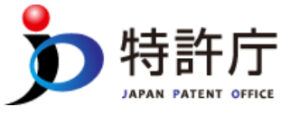Overview of design non-easiness to create
If you do not meet the difficulty of creating a design, you will be rejected (Article 3, Paragraph 2 of the Design Law).
To put it simply, the difficulty of creating a design is the difficulty of creating a design based on a known design.
Although novelty is required as a requirement for design registration (Article 3, Paragraph 1, Items of the Design Law), even if the design is novel, it is easy for a person concerned to create it based on a known design. Designs that can be created have a low protective value, and if such designs are protected, the implementation of others will be unreasonably restricted, and the development of the industry will be hindered.
Therefore, in order to protect only designs that have true protective value, the non-easiness of creation is a registration requirement.
Article 3, Paragraph 2 of the Design Law
A shape, etc. that is publicly known in Japan or abroad by a person who has ordinary knowledge in the field to which the design belongs before the application for design registration, is described in a distributed publication, or is made available to the public through a telecommunications line, etc. Or, if a design can be easily created based on an image, the design cannot be registered for that design, notwithstanding the provisions of the same paragraph.
Judgment subject of creative non-easiness
Those skilled in the art are the ones who judge the non-easiness of creation.
A person skilled in the art is a person who has ordinary knowledge about a design in the industry at the time of filing an application for registration of the design in an industry that manufactures or sells an article related to the design.
Examples of easy-to-create designs
As shown below, (1) replacement design, (2) jumbled design, (3) design by simply deleting some configurations, (4) design by changing the layout, (5) design by changing the composition ratio, and (6) the number of consecutive units. Designs that are increased or decreased, and (7) designs that are used or diverted beyond the framework of goods, etc., are denied ease of creation as designs that are easy to create.
① Replacement design
(The example below is quoted from the design examination criteria)
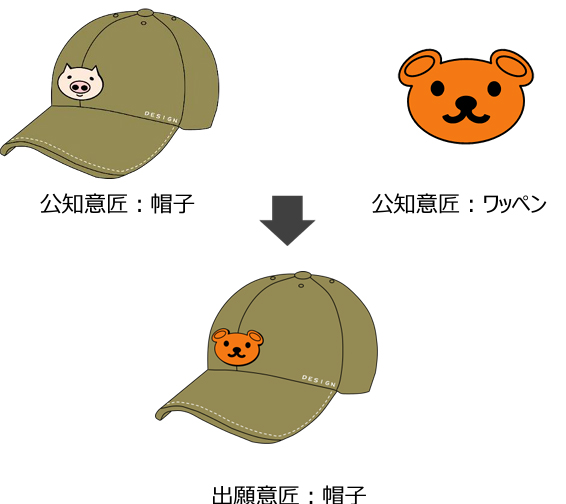
A design in which the pig emblem part of a known hat design is replaced with a known bear emblem is a replacement design, and the non-easiness of creation is denied, and the application for design registration is rejected.
② A collection of designs
(The example below is quoted from the design examination criteria)
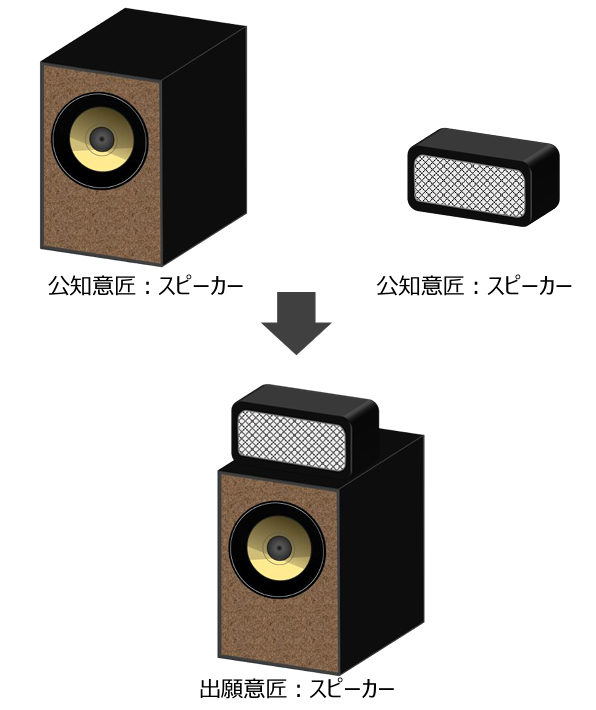
The design of a speaker with a known tweeter mounted on a known full-range speaker unit is denied the ease of creation as a collection of designs, and the application for design registration is rejected.
③ Design by simply deleting some configurations
(The example below is quoted from the design examination criteria)
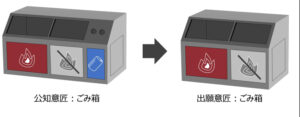
A design in which a part of the known trash can design (the trash can part for a blue can) is deleted is denied the easiness of creation as a design simply by deleting a part of the structure, and the design registration application is rejected.
④ Design by changing the layout
(The example below is quoted from the design examination criteria)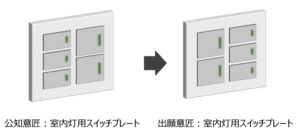
A design in which the arrangement of buttons on a known interior light switch plate has been changed is denied the easiness of creation as a design due to the change in arrangement, and the application for design registration is rejected.
⑤ Design by changing the composition ratio
(The example below is quoted from the design examination criteria)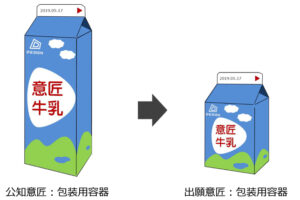
A milk carton design that is a shortened design of a known milk carton is denied the ease of creation as a design due to a change in the composition ratio, and the design registration application is rejected.
⑥ Design by increasing or decreasing the number of consecutive units
(The example below is quoted from the design examination criteria)
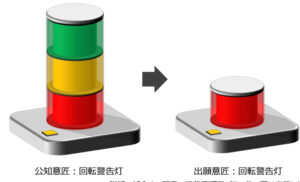
Of the known green / yellow / red rotation warning lights, the design of the rotation warning light from which the green / yellow rotation warning light has been removed has been denied the easiness of creation as a design due to an increase or decrease in the number of consecutive units. The design registration application will be rejected.
(7) Designs by using or diverting configurations that transcend the boundaries of goods, etc.
(The example below is quoted from the design examination criteria)

A design that uses a known apple design as an article paper weight is denied the non-easiness of creation as a design that uses or diverts a structure that transcends the boundaries of articles, etc., and the application for design registration is rejected.
In addition, a design in which the shape of the Eiffel tower is used as a figurine, a design in which the shape of a known automobile is expressed as an automobile toy, and a design in which the shape of a known desktop computer is expressed as chocolate almost as it is. However, the non-easiness of creation is denied as a design by using or diverting the composition beyond the frame of goods.
Case law regarding non-easiness of creation (March 19, 1974, Supreme Court, Third Small Court)
In dismissing the appellant's allegation that the registered design is invalid because it falls under Article 3.2 of the Design Act (hereinafter referred to as the "Act"), the original judgment shall be the same or similar article. Since the registration requirement is that the design related to the design has creativity, and paragraph 2 of the same Article requires that the design related to the article other than the right has creativity, it is like a hose for the registered design. In order to judge whether a design has creativity in relation to articles in the same field, it is explained that there is no room to apply paragraph 2 of the same article, as it is solely according to paragraph 1 of the same article. I think that a design is an integral part of an article, so it is a design that is publicly known in Japan or abroad before the application for registration, or a design that is described in a publication distributed in Japan or abroad before the application for registration. In order to refuse registration pursuant to Article 3.1 of the Act on the grounds that the design is the same or similar, it is first necessary that the articles related to the design are the same or similar, and the design itself is also the same or similar. Must be considered similar.
However, as is clear from the provisions of Article 2, Paragraph 2 of the same Article is different from the issue of the same or similar design as the one in which Paragraph 1 of the same Article is associated with a specific article, and is different from that of an article. Based on the shapes, patterns or colors widely known in Japan as abstract motifs that are not related to each other, or the combination of these, the registration requirement is that the design cannot be easily created by a person skilled in the art. Therefore, the similarity of the articles to which the motif is connected is not a problem.
Further considering the relationship between Paragraph 1, Item 3 of the same Article and Paragraph 2 of the same Article, Paragraph 1, Item 3 of the same Article states that the effect of the industrial right is a design similar to the registered design, that is, an article relating to the registered design. It is said that the same or similar articles extend to designs that give general consumers a similar aesthetic appearance to registered designs (Article 23 of the Act). Therefore, general demand for designs of articles such as the one on the right. While the issue is the similarity of aesthetics from the standpoint of a person, Article 3 (2) removes the restriction that the goods are the same or similar, and is viewed from the standpoint of a person concerned based on a socially widely known motif. It is a matter of originality and not new ideas of design, and it is understood that the two are rules that have different foundations of thinking.
Therefore, even between designs related to the same or similar articles, the similarity is judged based on the similarity of the design effects and the shape, pattern, color, etc. of one of the designs. It does not necessarily match the judgment of ease of creation in paragraph 2 of the same article as to whether or not the trader could easily create the other design, it is a similar design, and the creation of paragraph 2 of the same article is easy. At the same time, it cannot be said that it is a similar design because the design effect is different, but there are cases where the ease of creation set forth in paragraph 2 of the same Article is recognized, so the former is just In that case, it is sufficient to refuse the registration by applying only the provisions of paragraph (1), item (iii) of the same Article according to paragraph (2) of the same Article and this document.
At the same time, Article 49, item 3 of the Act states that "a design listed in the preceding two items by a person who has ordinary knowledge in the field to which the design belongs before the application for registration of the design (a design publicly known in a foreign country before the application for registration and an application for registration). The period for requesting a trial for invalidation of registration is limited for "designs when the design can be easily created based on the design described in the publication previously distributed in a foreign country). There is no other way to impose a substantive provision that stipulates the corresponding reason for invalidation of registration, except for Article 3, Paragraph 1, Item 3, but from this immediately, the meaning of "similarity" stipulated in Article 3, Paragraph 1, Item 3 is used. It is understood to be synonymous with the ease of creation, and paragraph 1, item 3 of the same Article stipulates refusal of registration for designs that could be easily created by those skilled in the art based on the designs listed in items 1 and 2 of the same Article. It is not appropriate in the light of the above instruction to understand that.
Therefore, unlike the right, it should be said that there is an illegality in the judgment of the trial court that there is no room for applying paragraph 2 of the same Article to the design of the same or similar goods, which is misinterpreted in the same Article.





